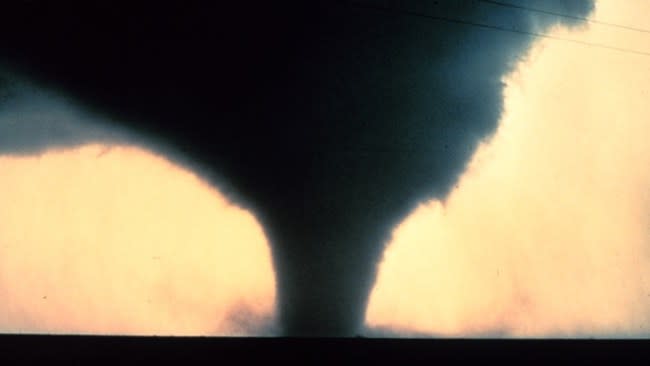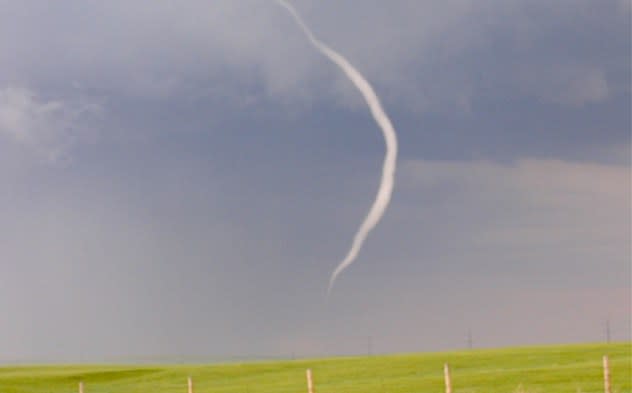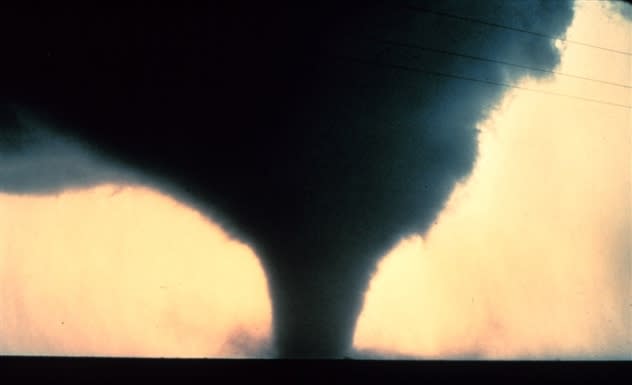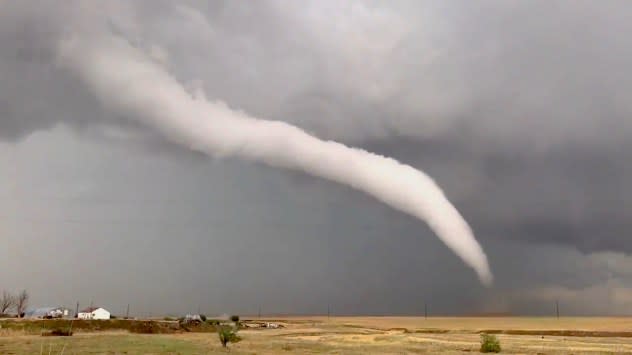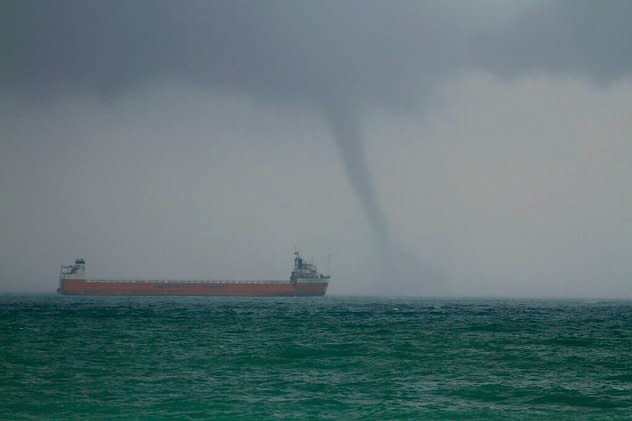10 types of tornadoes that occur in the US
Tornadoes are some of the most extreme weather events on Earth, and just like snowflakes, no two tornadoes are the same.
No matter their shape or size, every type of twister can be dangerous, with the most powerful capable of wiping out an entire town in mere minutes. Here are 10 different types of tornadoes that have been documented across North America.
The smallest type of tornado can be short-lived, lasting just a few minutes, but that is not always the case. Rope tornadoes, named after their long, thin appearance, can be just the start of the evolution of a twister.
 |
A rope tornado spotted near LaGrange, Wyoming, on June 5, 2009. (NOAA/VORTEX II) |
Even a thin rope tornado can cause damage, although the path of destruction tends to be narrow compared to other kinds of whirlwinds.
Some of the most iconic photos of tornadoes are those depicting cone tornadoes. These twisters are larger than rope tornadoes and can be far more destructive.
 |
A cone tornado near Seymour, Texas, on April 10, 1979. (NOAA Photo Library, NOAA Central Library; OAR/ERL/NSSL) |
As their name suggests, they are shaped like an ice cream cone and become narrower as they extend downward toward the ground.
In the tornado family tree, the stovepipe is the cousin to the cone tornado. The two types are similar in size but differ in shape.
While the width of a cone tornado tapers as it extends downward, stovepipes are about the same width from where they meet the ground up to where they connect with the base of the parent thunderstorm.
Meteorologists use strange terms to describe different phenomena, ranging from bear's cage to turkey towers. One type of twister falls under this category.
An elephant trunk is about the same size as a cone or stovepipe, but instead of being vertical, it curves like the trunk of an elephant.
 |
A tornado near Keenesburg, Colorado, on June 19, 2018. (AccuWeather/Reed Timmer) |
On June 18, 2018, Extreme Meteorologist Reed Timer intercepted a tornado near Keenesburg, Colorado, northeast of Denver, that started as a rope, grew into a cone and then became tilted and elongated to form an elephant trunk. This footage is a textbook example of how tornadoes can take on many forms throughout their lifespan.
The most destructive and catastrophic tornadoes are the massive wedge tornadoes, which can grow to be over a mile in diameter.
Some of the most notorious twisters in U.S. history were wedge tornadoes, including the EF5 that leveled Joplin, Missouri, on May 22, 2011, and the El Reno tornado, which was a jaw-dropping 2.6 miles wide as it raced across central Oklahoma on May 31, 2013.
 |
A large tornado spinning near Morton, Texas, on May 23, 2022. (Marcus Diaz via Storyful) |
Wedge tornadoes have several nicknames, including ground scrubbers, as they often scour the Earth along their path. Additionally, EF5 wedge tornadoes are sometimes referred to as the "finger of God" due to their destructive power, a term popularized in the storm-chasing vernacular following the debut of the 1996 movie Twister.
Powerful tornadoes can be more than just a single spinning column of air. Some twisters, especially those that are large, can have multiple areas of rotation embedded in the primary funnel.
It may be impossible to see the different vortexes swirling around the tornado while it's happening, but the various vortexes can be evident during post-storm damage surveys.
Intense tornadoes can occasionally be accompanied by smaller funnels, known as satellite tornadoes, that rotate around the primary area of circulation, similar to the way satellites orbit the Earth.
Because of the similarities, satellite tornadoes can sometimes be misidentified as multi-vortex tornadoes.
One of the rarest tornadic phenomena that even some veteran storm chasers have never witnessed are twins when two bona fide tornadoes form side by side. This is different from multi-vortex or satellite tornadoes as twins develop from two distinct areas of circulation.
Twin tornadoes can also be referred to as sisters.
 |
In this file photo from June 16, 2014, two tornados approach Pilger, Neb. (AP Photo/Eric Anderson, File) |
One of the most iconic examples of twin tornadoes took place near Pilger, Nebraska, on June 16, 2014. More recently, twins were spotted near Richland, Iowa, during a severe weather outbreak on March 31, 2023.
A landspout can look like a tornado at a glance, but a closer look reveals that the two differ in origins.
Unlike tornadoes spawned by rotating thunderstorms, landspouts start as a column of spinning air near the ground and are not connected to the base of a rotating thunderstorm. They tend to be weak and short-lived, but stronger landspouts can produce damage similar to tornadoes.
Landspouts are also different from dust devils, which can form on warm, sunny days when no thunderstorm is in sight.
Whirlwinds are not limited to land. When inclement weather unfolds over water, it can lead to the formation of a waterspout.
Any tornado that occurs over water is classified as a waterspout, and when one moves over land, it is designated as a tornado.
 |
A cargo ship sails near the path of a waterspout near the beach in Fort Lauderdale, Fla. Monday, Jan. 25, 2010 as thunderstorms move into the area. (AP Photo/J Pat Carter) |
Waterspouts are generally weak and look similar to rope tornadoes, but they can form without the help of a supercell thunderstorm. When the conditions are right, any thunderstorm or strong rain shower can generate a waterspout. In some instances, multiple waterspouts can form in close proximity to one another.
Want next-level safety, ad-free? Unlock advanced, hyperlocal severe weather alerts when you subscribe to Premium+ on the AccuWeather app. AccuWeather Alerts™ are prompted by our expert meteorologists who monitor and analyze dangerous weather risks 24/7 to keep you and your family safer.
